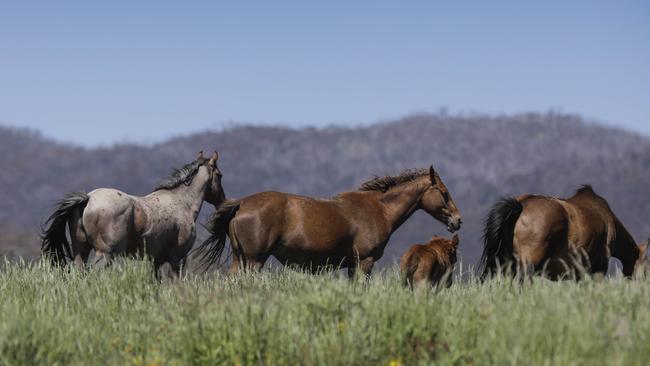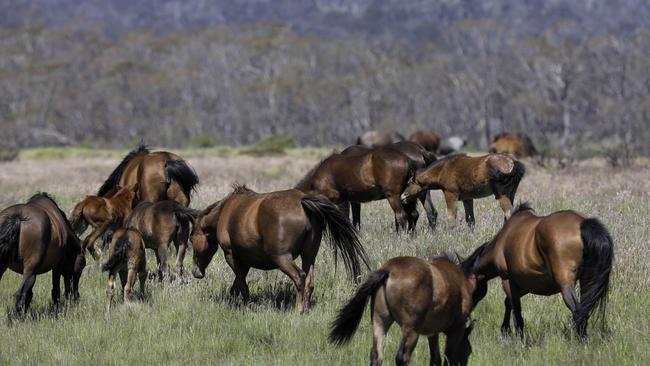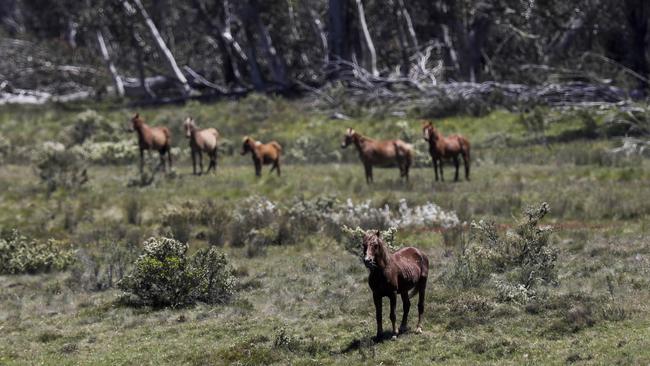Alpine brumbies seem a protected feral species
In a year when an estimated three billion native animals were killed or displaced by fires, we’ll end up with more feral horses than we started with — thanks to gun-shy politicians.

If you could choose to be any pest animal living in an Australian alpine national park in 2020, you’d be pretty safe choosing to be a brumby.
You certainly wouldn’t want to be one in northern Australia, where feral horses are routinely culled from helicopter without fuss or fanfare, nor in the ACT, which has a zero-tolerance policy to the animals in its national parks and shoots any border-crossers. You wouldn’t want to be a feral deer, pig, or a goat in the alpine national parks. They are on the receiving end of the biggest aerial shooting program in NSW history in response to pressures brought on by last summer’s bushfires, with more than 2000 already dispatched. Dogs, cats and foxes will have to evade 1 million poison baits and ground shooters. But things are pretty safe if you’re a brumby, whose numbers last year were estimated to be 25,000 across the Alps.
Sure, it got a bit dicey last summer when bushfires tore through a third of Kosciuszko National Park, but the horses escaped the fires largely unscathed, concentrating their numbers into the last remaining unburnt patches of habitat shared with the surviving native animals.
So here’s the kicker. In a year when an estimated three billion native animals were killed or displaced by fires, all indications are that we’ll end the year with more feral horses in alpine national parks than we started with.
It wasn’t just bushfire the horses dodged. In February, NSW Environment Minister Matt Kean announced all brumbies would be removed from Nungar Plain, with significant reductions in the Cooleman and Kiandra Plains — areas where numbers were estimated to be about 4000. But so far just 312 have been removed. Of those, the vast majority were rehomed, with 14 going to the knackery and 46 released back into the park. With an annual rate of increase of about 23 per cent, recent NPWS surveys reveal that horse numbers in those northern plains have already risen by nearly 400 on the same time last year, in what’s shaping up to be a bumper foaling season.
In the ongoing political saga that is brumby management in NSW and Victoria, it’s been quite a year. Court challenges by brumby supporters to halt culling or removals were heard in the Federal Court, Victoria’s Supreme Court and NSW Land and Environment Court, losing on every occasion but succeeding in delaying horse management. The stoush between NSW Deputy Premier John Barilaro and Kean went into overdrive, with Kean eventually capitulating to Barilaro’s repeated insisting on a recount post-bushfires. Barilaro then turned his attacks to NPWS, labelling his own government’s agency “National Sparks and Wildfires” and “bastards”. Brumby supporters became especially volatile, discussing how to sabotage trap sites, threatening insurgency in the bush and prompting a police investigation into a plan to dump horse heads on the front lawn of Kean’s house. Brumby skulls were later displayed on sticks outside a NPWS office.
In the wicked world of brumby battles, it’s been a year where and lot has happened but ultimately nothing has happened — the horses remain firmly embedded. And that’s a big win for brumbies and their supporters.
“Maybe they’re winning, I’m just not sure what the prize is,” says the Invasive Species Council’s Indigenous ambassador and Snowy Mountains local Richard Swain. “But I do know that every day this country is suffering. I just wish that Australians would learn to love Australia and the species that evolved here.”
A study released in February by the University of Sydney showed that nearly one in five people believed horses to be native to Australia, increasing the likelihood of their opposition to culling. In what should be an open and shut case of managing a damaging pest animal on public land, conservationists and park managers struggle to generate widespread public enthusiasm, coming up against a middle ground where the default starting point is naturally sympathetic towards the horses.

Politicians on all sides are literally gun-shy when it comes to advocating culling. In a statement to Inquirer, Barilaro said he supported some horse removal in Kosciuszko National Park but didn’t want “a repeat of the Guy Fawkes massacre”, referring to the last time feral horses were aerially culled on public land in NSW at Guy Fawkes National Park in northeast NSW in 2000. The cull triggered a public and media backlash so great that no politician has dared go near the practice again, despite aerial culling being endorsed by the RSPCA and being realistically the only chance of meaningfully reducing horse numbers.
Conservationists do have one potent weapon when it comes to convincing the doubters: showing people the horse damage first-hand. Last Saturday this newspaper reported on federal Environment Minister Sussan Ley’s visit to Kosciuszko National Park, when she expressed shock at the damage caused by horses and called on the NSW government to do more. The minister announced federal funding of $8m go towards bushfire recovery in fragile alpine ecosystems, including to “mitigate the impact of hard-hooved animals”.
Responding to Ley’s comments, Barilaro said he welcomed the federal government’s funding but added: “Trying to play politics on both sides is unhelpful.”
In 2018, Barilaro passed the Kosciuszko Wild Horse Heritage bill (dubbed the “Brumby Bill”), supplanting the government’s 2016 Draft Wild Horse Management Plan, which set a target to reduce horse numbers to 600 in the park over 20 years. Since the Brumby Bill, horse removals have stagnated. In the 2018-19 financial year, no horses were removed. This year it’s 312. With the current removal rate being less than 10 per cent of the number of foals added to the park each year, the question becomes why bother? Barilaro meanwhile maintains many horses were killed in the bushfires.
In October, Invasive Species Council CEO Andrew Cox threw up his arms saying: “If you’re not going to effectively control feral horses in national parks you’re better off handing the land back to the graziers.”
The comment might sound factious, but it goes to the heart of an important impasse in the brumby battle. That’s because a return to pastoralism in Kosciuszko National Park is exactly what many brumby supporters are hoping to achieve.
Their tool was to be the Wild Horse Community Advisory Panel (CAP), set up under the Brumby Bill to guide the environment minister on the creation of a new horse management plan. Earlier in the year two of the eight members quit after Barilaro’s hand-picked chair Tim Johnson split from the panel and wrote his own draft report advocating brumby management return to old methods such as roping and brumby-running, in a move designed to transition control of brumby management from NPWS back to pastoralists. However, an internal bust-up in the brumby camp led to Johnson moderating his stance and redrafting the plan with consultation from the panel. The members who quit have since rejoined.
Inquirer understands the final CAP report — expected to be made publicly available around February — will recognise that the damage being done by feral horses represents a major threat to local Indigenous people’s sense of belonging to country. With the Rio Tinto destruction of Juukan Gorge fresh in mind, it’s a savvy play from conservationists on the panel as they seek to reframe the argument from brumby versus gun to colonial cultural versus Indigenous heritage.

The story of stilted horse removal is just as stark in Victoria, where in May Parks Victoria saw off a Federal Court challenge by the Australian Brumby Alliance, which argued that removing horses from Alpine National Park would impinge on national heritage values of the alps. But just as Parks Victoria was gearing up to send in the cullers, Phil Maguire arrived on the scene. The West Gippsland man, who owns a part share in a lifestyle block bordering Alpine National Park near Anglers Rest, announced plans to muster brumbies out of the national park and shelter them on his land. But he and other self-styled cattlemen returned empty-handed.
Maguire then announced he was standing down from any leadership position in the brumby battle after questions were put to him about homophobic and racist posts he made on a social media website. He returned though, to challenge Parks Victoria in the Supreme Court, arguing the agency was obliged to carry out public consultation before ground shooting horses. But the court ruled he had no standing, and that Parks Victoria was not required to consult, and threw his case out. Maguire appealed against the decision and lost, so took the case to the High Court, before pulling out on Thursday, the day before his application for leave to appeal was to be heard. Maguire claimed on Thursday that Parks Victoria had signed an affidavit agreeing not to shoot horses for the remainder of the current action plan. Inquirer can confirm Parks Victoria has made no such commitment.
But the Australian Brumby Alliance stridently opposes any cull. President Jill Pickering says Parks Victoria has the capacity to cull all Victoria’s brumbies in a few weeks. “Australia will be the loser by the killing off of its Victorian social heritage,” she said.
Over in the headwaters of Tantangara Creek, Swain watches on as mobs of horses congregate around the waters. It’s the last spot in the world where the critically endangered stocky galaxias fish hangs on. “I’m not optimistic,” Swain says. “But I’m hopeful that Australians will accept this country as their heritage. This issue is about country, about listening to your country. We’re doing a lot of talking, but no one’s listening to country.”

To join the conversation, please log in. Don't have an account? Register
Join the conversation, you are commenting as Logout